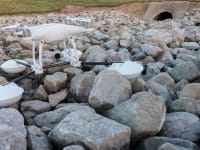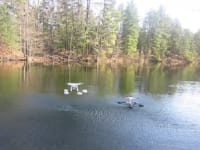The patent pending WaterStrider is a multi-terrain landing system which works with the existing landing gear of the DJI Phantom 4 and Phantom 3 to allow easy and safe landings almost anywhere. Until now the only option for landing a drone on water or uneven terrain was to purchase a separate and expensive water drone or rig a home-made solution. This limited the environment where a drone could be used or encourages dangerous mid-air catches.
WaterStrider allows owners to use their existing drones on water, tall grass, snow, sand, rocks, and mud. It means arriving on site and not worrying about where to land and where to take-off. With an easy, 1 minute, installation process the WaterStrider can be detached and reattached quickly depending on need.
Drones have opened up a world of adventure and freedom to photographers. They have revolutionized industries like search and rescue and surveying. The DJI Phantom is one of the most popular drones in the world and is often the first choice for people new to flying and businesses looking to add drones; however, the landing gear for the Phantom has always been one of the weakest design elements. Optimum take-off and landing sites are a limiting factor for getting a drone into an area for search and rescue, surveying, or the perfect shot. Unlike hobbiests, professionals cannot always wait for perfect conditions or level surfaces. WaterStrider eliminates that concern and allows for fast, clean landings almost anywhere by almost anyone.
WaterStrider is constructed from high-strength injection-molded polymer mounts, light-weight and high strength carbon fiber legs, and high-impact polymer landing pods. Designed for perfect balance and buoyancy, the WaterStrider is an elegant balance of the many competing factors of durability, strength, weight and aerodynamic efficiency.
The design employs biomimicry of a water strider bug with the forward landing pods spread wider than the aft; increasing stability in forward-motion landing and preventing any obstruction of the camera view. The fine-tuned positions of the landing pods is a result of numerous development and testing iterations to minimize aerodynamic penalties resulting in endurance reduction of less than 30%. Strength of the components was optimized for minimum possible system weight using structural analysis and tested against manned aircraft standards, resulting in a system weight of less than 0.3 kilograms.
Materials and parts have been sourced from multiple vendors and manufacturers within the United States to insure quality product, delivered on time. Most of the parts will be manufactured outside the DroneRafts facility, but every unit will be finished and packed by DroneRafts' staff in Indianapolis, Indiana.
Video
Like this entry?
-
About the Entrant
- Name:Adam Morrison
- Type of entry:teamTeam members:Adam Morrison; David Moser; Zacheriah Cole
- Software used for this entry:Rhinocerous, Creo, Autodesk Simulation
- Patent status:pending








